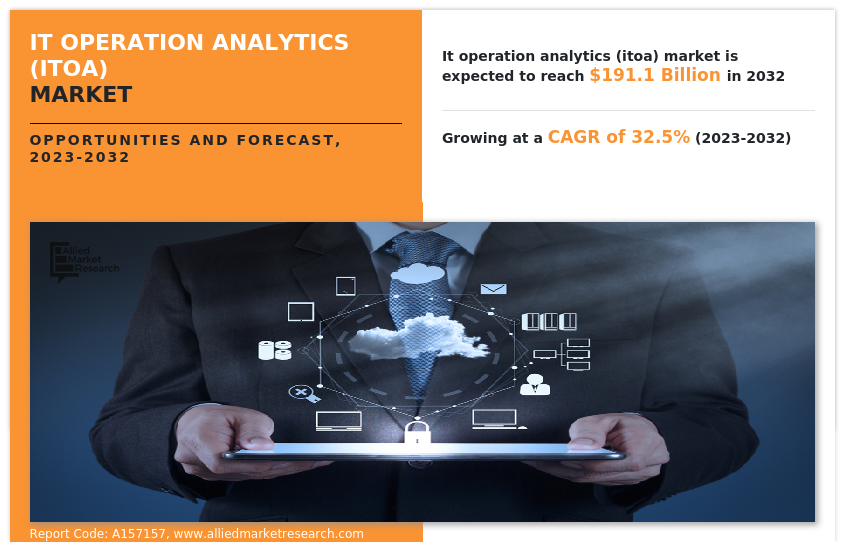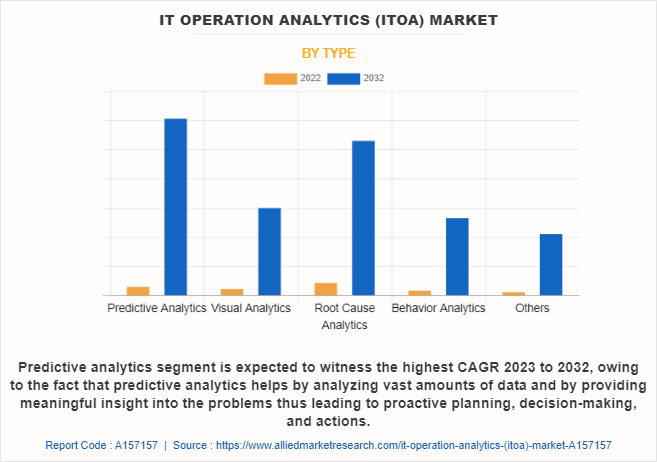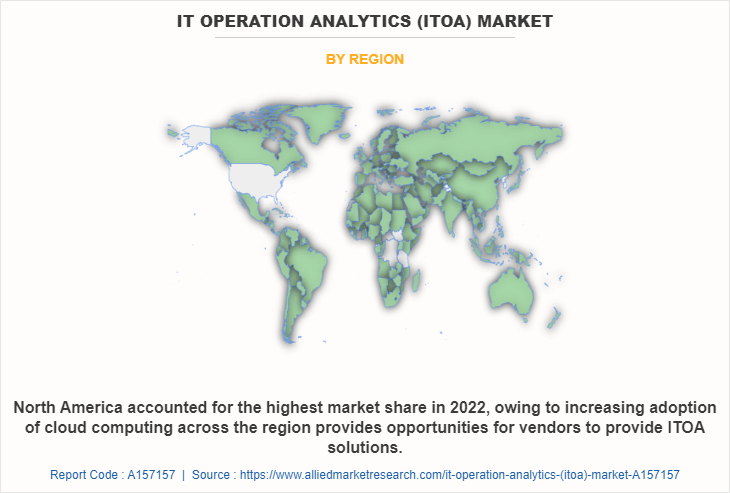IT Operations Analytics Market Size & Insights:
The global IT operations analytics market was valued at USD 11.7 billion in 2022 and is projected to reach USD 191.1 billion by 2032, growing at a CAGR of 32.5% from 2023 to 2032.
The increase in focus on enhancing operational efficiency is a fundamental driver behind the widespread adoption of IT operation analytics solutions. ITOA solutions enable data-driven decision making by analyzing vast amounts of IT operations data. These insights help IT teams identify inefficiencies, bottlenecks, and areas for improvement, enabling them to make informed decisions to enhance operational performance. Moreover, ITOA solutions offer real-time monitoring and automated alerting mechanisms. ITOA allows IT teams to respond proactively, reducing downtime and minimizing the impact of operational disruptions by promptly detecting anomalies, performance issues, and potential incidents. In addition, rise in need for real-time insights and proliferation of huge amounts of IT operations data are further driving the growth of the IT operations analytics market.

However, increase in complexities and data security concerns are major factors hampering the growth of the ITOA market. Integrating and correlating data from different platforms, systems and technologies can be a complex task, causing delays and difficulties in implementing ITOA solutions. Furthermore, data security is becoming a major concern as organizations collect and analyze vast amounts of IT operational data. ITOA solutions handle sensitive information including system logs, performance metrics and security events. Contrarily, increase in adoption of artificial intelligence and machine learning presents a significant opportunity for the IT operation analytics industry. The widespread adoption of artificial intelligence (AI) and machine learning (ML) is transforming the IT operations analytics market and fundamentally changing the way organizations manage and analyze their IT performance data. AI and ML technologies are evolving into powerful tools that can leverage the vast amounts of data generated by complex IT infrastructure to enable more insightful decision-making.
IT operations analytics (ITOA) is the method used to monitor systems and gather, process, analyze and interpret data from various IT operations sources, to identify potential threats, and assist in making decisions. Information is gathered from both live and older data from applications, services, and infrastructure hardware logs. Other than aforementioned sources, IT operation analytics gathers data from other sources such as software agents running in operating systems or hypervisors gathering data relevant to IO, transactions, and resource usage.
The report focuses on growth prospects, restraints, and trends of the IT operations analytics market analysis. The study provides Porter’s five forces analysis to understand the impact of various factors, such as bargaining power of suppliers, competitive intensity of competitors, threat of new entrants, threat of substitutes, and bargaining power of buyers, on the IT operations analytics market.
Segment Review:
The IT operations analytics market is segmented on the basis of component, type, deployment mode, enterprise size, end user and region. On the basis of component, it is bifurcated into solution and service. By type it is segmented into predictive analytics, visual analytics, root cause analytics, behavior analytics, and others. By deployment mode, it is divided into on-premise, and cloud. By enterprise size, it is bifurcated into large enterprises, and small and medium-sized enterprises. On the basis of end user, it is classified into BFSI, healthcare, retail and e-commerce, manufacturing, government, telecom, and others. On the basis of region, it is analyzed across North America, Europe, Asia-Pacific, and LAMEA.

On the basis of type, the root-cause analytics segment attained the highest IT operations analytics market size in 2022 owing to increase in IT operations data, a number of sensors for fault diagnosis, and the number of Internet of Things (IoT) devices which has led to an increase in the demand for root cause analytics in enterprises. The root cause is the primary reason for the drop in the quality or the overall device/equipment effectiveness of an asset. The use of analytics in this domain has gained prime importance.

On the basis of region, North America held the highest IT operations analytics market share in 2022. This is attributed to the fact that U.S.-based companies are the most successful and advanced in their implementation of operational analytics initiatives. The regional market growth is primarily driven by the U.S. Moreover, the U.S. government is instrumental in making concrete decisions in the domain.
The report analyzes the profiles of key players operating in the IT operations analytics market such as Oracle, IBM, Cisco Systems, Inc., SAS Institute Inc., Broadcom, Microsoft, Hitachi, Ltd., Micro Focus, BMC Software, Inc., and SAP SE. These players have adopted various strategies to increase their market penetration and strengthen their position in the IT operation analyticss market.
Top Impacting Factors:
Proliferation of Huge Amounts of IT Operations Data
With modern enterprises relying heavily on complex and interconnected IT infrastructures, data generated from various sources, including logs, performance metrics, and security events has become overwhelming for traditional monitoring and analysis methods. ITOA solutions use advanced analytical techniques such as artificial intelligence and machine learning to process, analyze and understand massive amounts of data in real time. ITOA enables IT teams to quickly identify and resolve potential issues, minimizing downtime and service disruption by providing real-time insights and proactive problem detection.
In addition, ITOA solutions optimize the performance of IT systems by identifying bottlenecks and inefficiencies, while enhancing security through advanced threat detection and compliance monitoring. Organizations can allocate resources efficiently and make informed decisions that improve overall business outcomes through data-driven decision-making. Furthermore, the adoption of cloud computing services provides organizations with scalable infrastructure and enables them to store and process vast amounts of data. Cloud-based applications generate extensive logs and performance metrics, adding to the data volume. Therefore, these trends are driving the IT operations analytics market growth.
Increase in Focus on Enhancing Operational Efficiency
The increase in the need for real-time insights means that businesses want to have instant and up-to-date information about their computer systems and how they are performing. As technology becomes more complex and faster, it is critical for organizations to have the tools to quickly monitor and analyze IT operational data. These tools collect and process large volumes of data from various sources such as logs, performance metrics, and user activity in real time. Furthermore, ITOA solutions enable organizations to maintain a high level of service quality, by providing real-time insight into IT system performance, availability and security. They help to immediately identify and resolve performance bottlenecks, application slowdowns and potential security threats, reducing downtime and ensuring business continuity.
For instance, in May 2023, Everstream Analytics, the company working in global supply chain insights and risk insights announced the launch of Everstream Connect. The new platform works with the end-to-end supply chain risk management platform and connects to deliver intelligent mapping and visibility into logistics network flow. Therefore, these strategies are projected to further foster the growth of the IT operations analytics market.
Rise in Need For Real-time Insights
The increase in the need for real-time insights means that businesses plan to focus on getting instant and up-to-date information about their computer systems and their performance. As technology becomes complex and faster, it is critical for organizations to have the tools to quickly monitor and analyze IT operational data. This is where IT operations analytics solutions helps them. These tools collect and process large volumes of data from various sources such as logs, performance metrics, and user activity in real time.
Furthermore, by providing real-time insight into IT system performance, availability and security, ITOA solutions enable organizations to maintain a high level of service quality. They help to immediately identify and resolve performance bottlenecks, application slowdowns and potential security threats, reducing downtime and ensuring business continuity. For instance, in May 2023, Everstream Analytics, the company working in global supply chain insights and risk insights announced the launch of Everstream Connect. The new platform works with the end-to-end supply chain risk management platform and connects to deliver intelligent mapping and visibility into logistics network flow. Therefore, these strategies are projected to further foster the growth of the IT operations analytics market.
Increase in Complexities and Data Security Concerns
Organizations are deploying modern IT architecture to make IT infrastructure more dynamic and agile, using virtualization technologies such as cloud, containers, and virtual machines. Many organizations have adopted containers, due to which the adoption of cloud-based solutions is rising, and most companies are migrating their applications on the cloud. The dynamic nature of the cloud-based and analytics technologies has enabled businesses to adjust to the fluctuating demand for resources However, this has resulted in decreased visibility for organizations, as workflows and workloads are far from their existing physical IT infrastructure. This creates problems in pinpointing potential issues.
Moreover, modern IT environments have become very complex, consisting of on-premises infrastructure, virtualized systems, and various applications. This complexity makes it difficult to efficiently collect and analyze data from disparate sources. Integrating and correlating data from different platforms, systems and technologies can be a complex task, causing delays and difficulties in implementing ITOA solutions. Furthermore, data security is becoming a major concern as organizations collect and analyze vast amounts of IT operational data. ITOA solutions handle sensitive information including system logs, performance metrics and security events. Ensuring the confidentiality, integrity, and availability of this data is critical to preventing data breaches, unauthorized access, and other security threats. Therefore, these factors are anticipated to restrict the growth of the ITOA market.
Increase in Adoption of Artificial Intelligence and Machine Learning
The widespread adoption of artificial intelligence (AI) and machine learning (ML) is revolutionizing the IT operations analytics market and fundamentally changing the way organizations manage and analyze their IT operations data. AI and ML technologies have evolved into powerful tools that can harness the vast amounts of data generated by complex IT infrastructures to enable efficient and insightful decision-making processes. Moreover, one of the main impacts of artificial intelligence and machine learning on ITOA is advanced data analytics. These technologies can process large amounts of data in real time and detect patterns, anomalies and trends that are difficult to detect manually. This enables ITOA solutions to deliver valuable insights and actionable intelligence to improve IT operations.
In addition, artificial intelligence and machine learning in ITOA introduce predictive analytics that can predict potential problems before they occur. By analyzing historical data and system behavior, ITOA solutions can forecast performance bottlenecks, system failures, or security threats, allowing IT teams to take proactive measures and prevent disruptions. For instance, in October 2022, Accenture and Google Cloud announced an expansion of their global partnership through a renewed commitment to growing their respective talent, increasing their joint capabilities, developing new solutions using data and AI, and providing enhanced support to help clients build a strong digital core and reinvent their enterprises on the cloud, these organizations took advantages of the newest technical advancements to achieve their desired business goals.
Growth in Need of Companies For Holistic 360-degree Visibility
Businesses face many challenges to effectively manage and monitor their systems in the complex and interconnected IT environment. They need a complete, unified view of their IT infrastructure, applications, and services to make informed decisions, optimize performance, ensure security, and deliver a seamless experience for their customers. Thus, ITOA solutions offer the capabilities to collect, analyze, and visualize data from various sources, providing a holistic and real-time view of IT operations. This holistic visibility enables organizations to gain deep insights into their entire IT ecosystem, including on-premises and cloud environments, distributed networks, applications, and user interactions. With 360-degree visibility, companies can identify bottlenecks, detect anomalies, and foresee potential issues across the entire IT landscape, proactively addressing them before they escalate into critical problems.
In addition, the convergence of IT operations management (ITOM) and ITOA will lead to more integrated platforms that provide end-to-end visibility and monitoring capabilities. Organizations will seek solutions that combine ITOA insights with other IT management functionalities for seamless and efficient operations. Therefore, the growing need for holistic 360-degree visibility in IT operations presents promising opportunities for the ITOA market.
Market Landscape and Trends:
The growing dependence on software for operations, increasing consumption of big data, and the digitalization of industries powered by mobility and cloud are the prime factors driving the growth of the IT operations analytics market. Moreover, IoT-led data explosion and the use of Artificial Intelligence (AI) and Machine Learning (ML) for operation analytics are likely to foster the IT operations analytics market growth. Furthermore, there has been a rapid rise in the demand for ITOA tools that identify security gaps in network infrastructure as well as web & mobile applications and help reduce risks. Organizations are deploying high-end ITOA solutions to analyze the huge chunks of IT operational data to extract valuable insights with the shift of technologies from on-premises to cloud and the demand for the sustenance of market positions.
In addition, the ITOA industry is leveraging on the emergence of platform as a service PaaS, DevOps. PaaS as a delivery model for IT helpdesks and infrastructure monitoring has typically helped in incorporating log management, website monitoring, server monitoring and cloud management across complex, high-scale, and hybrid environment. Therefore, the IT operation analytics industry is constantly evolving, with new trends emerging as technology advances.
Key Benefits for Stakeholders:
- This report provides a quantitative analysis of the market segments, current trends, estimations, and dynamics of the IT operations analytics market forecast from 2022 to 2032 to identify the prevailing market opportunities.
- IT operations analytics market research is offered along with information related to key drivers, restraints, and opportunities of IT operations analytics market outlook.
- Porter's five forces analysis highlights the potency of buyers and suppliers to enable stakeholders to make profit-oriented business decisions and strengthen their supplier-buyer network.
- In-depth analysis of the IT operation analytics market segmentation assists in determining the prevailing IT operations analytics market opportunity.
- Major countries in each region are mapped according to their revenue contribution to the global market.
- Market player positioning facilitates benchmarking and provides a clear understanding of the present position of the market players.
- The report includes an analysis of the regional as well as global IT operations analytics market trends, key players, market segments, application areas, and market growth strategies.
IT Operation Analytics (ITOA) Market Report Highlights
| Aspects | Details |
| Market Size By 2032 | USD 191.1 billion |
| Growth Rate | CAGR of 32.5% |
| Forecast period | 2022 - 2032 |
| Report Pages | 310 |
| By Type |
|
| By Deployment Mode |
|
| By Component |
|
| By Enterprise Size |
|
| By End User |
|
| By Region |
|
| Key Market Players | Hitachi, Ltd., Microsoft Corporation, SAP SE, SAS Institute Inc., Micro Focus, Broadcom, Oracle, Cisco Systems, Inc., BMC Software, Inc., IBM |
Analyst Review
As per the insights of the top-level CXOs, IT operations analytics with artificial intelligence (AI) capabilities supports faster cloud deployment of digital products and services and trusted business insights. Therefore, it is a necessary component of any enterprise’s cloud journey now and in the foreseeable future. ITOA tools often leverage AI and machine learning algorithms to process and analyze vast amounts of data. As these technologies advance, they can deliver more accurate and actionable insights, further driving the adoption of ITOA solutions. Furthermore, as organizations continue to adopt cloud-based solutions, virtualization, and distributed systems, the complexity of IT environments grows. This complexity creates a demand for sophisticated analytics tools that can handle large volumes of data from diverse sources.
The CXOs further added that market players are adopting strategies like product launch for enhancing their services in the market and improving customer satisfaction. For instance, in December 2020, Broadcom Inc. launched AIOps latest generation solution. AIOps is an open platform with end-to-end observability, artificial intelligence, and machine learning that aids enterprises in achieving operational excellence. Using AIOps, business and IT leaders can proactively ensure improved customer and positive staff experiences while managing crucial KPIs that link IT outputs to business results and drive digital agility. This strategy was implemented to strengthen Broadcom Inc. position in the IT operations analytics market.
Moreover, some of the key players profiled in the report are Google LLC, Amazon Web Services, Inc., Cisco Systems, Inc., IBM, Microsoft, Huawei Technologies Co., Ltd., VMware, Inc., Docker Inc., Oracle, and Hewlett Packard Enterprise Development LP. These players have adopted various strategies to increase their market penetration and strengthen their position in the industry.
The key players profiled in the report include IT operation analytics market analysis includes top companies operating in the market such as Oracle, IBM, Cisco Systems, Inc., SAS Institute Inc., Broadcom, Microsoft, Hitachi, Ltd., Micro Focus, BMC Software, Inc., and SAP SE.
The key growth strategies of IT operation analytics players include product portfolio expansion, mergers & acquisitions, agreements, business expansion, and collaborations.
The IT operation analytics market is estimated to grow at a CAGR of 32.5% from 2023 to 2032.
Proliferation of huge amounts of IT operations data, increase in focus on enhancing operational efficiency and rise in need for real-time insights contribute toward the growth of the market.
The IT operation analytics market is projected to reach $191.0 billion by 2032.
Loading Table Of Content...
Loading Research Methodology...



